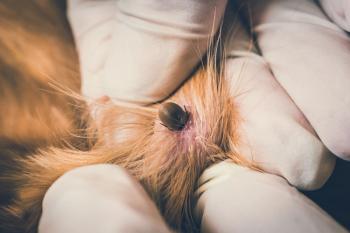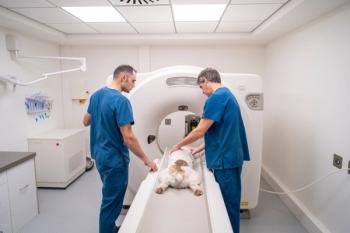
Semen quality and artificial insemination (Proceedings)
The semen factors thought to be most important to fertility are the number, the morphology and the motility of the spermatozoa.
The semen factors thought to be most important to fertility are the number, the morphology and the motility of the spermatozoa. There is a direct relationship between sperm production by the testes and testicular size. Therefore, larger dogs have higher sperm counts than smaller dogs. It has been reported that there is a relationship between sperm count and body weight. This may be true for animals in good body condition, but the relationship is lost in obese animals because testicular size does not increase. Even among breeds of similar size, there are variations in sperm counts. The total number of sperm in the ejaculate should be 300 million to 2 billion. In addition to the daily sperm production by the testicle, the number of sperm in semen is influenced by the number of sperm in the extragonadal reserves in the epididymis and ductus deferens, and also by the degree of arousal. Daily ejaculation immediately and dramatically diminishes the extragonadal sperm reserves. Within days, the sperm count will be substantially less than half of that on the first day. The extragonadal sperm reserves are normally replenished in a few days. The presence of an estrous bitch increases arousal, the number of sperm collected and the ease with which it is collected. A single subcutaneous dose of 0.1 mg/kg PGF2α (Lutalyse®, Pfizer), 15 minutes prior to semen collection has a similar effect. When both an estrous bitch and prostaglandin are used, the effects are additive and sperm counts may be increased by nearly 300%. Side effects of prostaglandin F2α are transient and mild, but also common. They include salivation, defecation and vomiting.
Semen is easily collected from most dogs. The dog is encouraged to ejaculate by rapid massage of the bulbus glandis through the prepuce. Canine semen is ejaculated in three fractions. The first fraction, or pre-sperm fraction, is composed of a few drops of clear fluid that originates from the prostate. Although this is uncommon, certain dogs may ejaculate several mls of the pre-sperm fraction. The second fraction is the sperm-rich fraction. The volume of the sperm-rich fraction varies from 0.5 to 5 ml, depending on testicular size and individual variation. The sperm-rich fraction appears cloudy and opalescent. Usually no attempt is made to separate the first two fractions. The third and largest fraction is prostatic fluid, of which there may be as much as 30 mls. Normal prostatic fluid is clear and easily distinguished from the milky, sperm-rich fraction. For routine semen evaluation and artificial insemination, it is sufficient to collect only enough prostatic fluid to ensure that the entire sperm-rich fraction has been obtained.
Motility is usually determined first because it is quickly affected by changes in temperature. The slide and coverslip should be maintained at 37° C. At least 70% of the sperm normally have rapid, steady forward progression. When chilled semen is warmed, the percent motile sperm is usually very similar to what it was before being chilled, however, it may not regain its previous vigor. The percent motility and the vigor are diminished in frozen-thawed semen. Sperm that move in circles or other non-linear patterns usually do so because of morphologic abnormalities in the midpiece or tail. At least 80% of the sperm should have normal morphology. Detached heads that are otherwise normal, and distal droplets are thought to be of minor significance, whereas other head and midpiece abnormalities, and proximal droplets are considered to be major abnormalities. Many abnormalities can be seen on unstained samples, but staining with Diff Quik® will improve evaluation, and other cells (WBCs etc) will also be identified. The Society for Theriogenology stain can cause bent tails in dog semen. The adverse effects on fertility of some morphologic abnormalities can be overcome by increasing the number of sperm inseminated; others can not. Freshly ejaculated sperm remain viable and capable of fertilization for at least 4-6 days in the estrous female tract. Frozen-thawed semen has a life span of about 24 hours and it does not penetrate cervical mucus very well. Therefore intrauterine, rather than intravaginal, insemination of frozen-thawed semen is critical to success.
The sperm count is usually determined using a hemocytometer and the sample is diluted with a WBC/platelet Unopette®. Oligozoospermic samples may not require dilution. Briefly, the hemocytometer has nine, 1x1 mm squares etched on it; the center 1 mm square has 25 subdivisions; and the coverslip is 0.1 mm above the etched surface. The spermatozoa in the outer four squares are usually counted unless the sample was so concentrated that the RBC unopette was used for dilution, in which case, the spermatozoa in 5 of the 25 subdivisions of the center square (5/25 = 1/5 mm) are counted. Whatever the method, the following factors are used to calculate the number of spermatozoa per milliliter:
Number of sperm counted:
Chamber is 0.1 mm deep → multiply by 10.
X number of 1 mm squares were counted → divide by X.
Sample was diluted → multiply by dilution factor.
1 ml = 1000 mm3 → multiply by 1000.
The number of sperm per milliliter of ejaculate is then multiplied by the volume (milliliters) of the ejaculate to obtain the number of sperm per ejaculate.
From CA Johnson: Current concepts on infertility in the dog. Waltham Focus 16:7, 2006.
Although pregnancies can be achieved with fewer sperm, a minimum of 200 million motile sperm is usually recommended for intravaginal artificial insemination in dogs. Doing so is expected to yield normal pregnancy rates and litter size. Fewer numbers of sperm, or samples with high numbers of abnormal sperm, yield lower pregnancy rates and/or smaller liter size. When less than 60-80% of the sperm are morphologically normal, or when progressive motility is less than 50%, canine pregnancy rates are poor. Dogs with suboptimal semen quality may be subfertile, rather than truly infertile. To achieve pregnancies with suboptimal semen quality, it is especially important that the female be fertile and in her reproductive prime, and that the timing of inseminations be ideal. In order to maximize the number of sperm in each ejaculate, at least 48 hours should elapse between breedings. It may be that subfertile dogs need longer than normal dogs to replenish the extragonadal sperm reserves. When using poor-quality semen, natural service or fresh semen will yield better results than trying to chill or freeze the sample.This is particularly true with frozen semen, because semen of suboptimal quality will not survive freezing as well as normal semen. The quality of frozen-thawed semen is invariably less than its pre-freeze condition.
Artificial insemination is used in dogs primarily when natural breeding cannot be accomplished. Transporting semen, rather than live animals, to distant geographic locations is a great advantage of AI over natural service. Artificial insemination is also used when behavioral problems, such as partner preference, or physical problems, such as vaginal prolapse, prevent copulation of the desired pair. Some dog breeders prefer AI because they believe that the risk of breeding trauma is minimized and that the stud is less likely to be exposed to infectious diseases carried by the bitch. In addition, a single ejaculate with sufficient numbers of spermatozoa can be divided and used to inseminate several bitches. The success of AI is determined by several factors, including the reproductive health of the animals, the quality of the semen, the timing and the number of inseminations, intravaginal versus intrauterine insemination, and the skill of the person performing the insemination.
It is important to document semen quality prior to insemination, because the success of the insemination will be no better than the quality of the semen. Knowing that semen quality is poor, the owner may then wish to use a different stud. Although pregnancies are occasionally achieved using fresh semen of inferior quality, the litter size is usually smaller. Usually no litters result if frozen-thawed semen of poor quality is used. In addition, once inseminated, the bitch should not be bred to a different male during that cycle, because paternity is uncertain unless DNA testing is done. Two inseminations should be performed at the optimal time during the fertile period. Pregnancy rates of 84% have been achieved with vaginal AI of fresh semen.
It has been shown that pregnancy rates from AI are improved when the semen is deposited directly into the uterus rather than into the cranial vagina. This is especially important when frozen-thawed semen is used because, relative to fresh or chilled semen, the frozen-thawed spermatozoa have a very short life span and poor ability to transverse the cervix. It has been estimated that to achieve similar pregnancy rates, at least 10 times the number of viable sperm are needed for vaginal AI than for intrauterine AI. Intrauterine insemination can be accomplished transcervically using specially developed catheters (Norwegian catheter; Norske Pelsdyrforlag A/L, Oslo, Norway) or endoscopically. These transcervical insemination techniques are commonly referred to as TCI. Intrauterine insemination can also be accomplished via laparoscopy or through a mini laparotomy.
The advantage of chilled extended semen over natural breeding or AI with fresh semen is that the semen, rather than the animals, can be transported. The advantage of chilled semen over frozen semen is that the pregnancy rates are better. Pregnancy rates and the longevity of chilled semen vary tremendously according to the type of extender and processing methods used. Properly extended and cooled semen of good quality can be stored at 5° C for 12 to 24 hours, and usually longer. Recently, new extenders have been developed that maintain sperm viability for 1-2 weeks at 5° C (
The greatest advantage of frozen semen is that cryopreservation is the only way in which the genetic potential of valuable male animals can be saved indefinitely. Using frozen semen, litters can be sired by a dog long after his death. Another advantage is that semen can be collected and stored whenever it is convenient to do so, in contrast to fresh or chilled semen, in which the timing is determined by the availability of cycling females. Conception rates achieved using frozen semen vary according to the extender and the sperm-processing techniques used (pellets versus straws, freezing rates, thawing rates). Pregnancy rates achieved with vaginal insemination using frozen-thawed semen of good quality have been about 30%, whereas pregnancy rates of 50% to 80% have been achieved when intrauterine insemination has been performed. The frozen semen should be accompanied by information from the collection and storage facility regarding the number of sperm in each straw or vial and the recommendations for thawing the semen. The latter is important because the ingredients in the extender influence the ideal thawing rates and temperatures, which have a significant effect on the post-thaw motility. For additional information on artificial insemination and regulations for international shipment of chilled and frozen canine semen, consult the International Veterinary Information Service (
Whatever method of insemination, the best results for pregnancy rates and litter size are achieved when bitches ≤ 6 years old are inseminated twice during the fertile period with semen of good quality from dogs ≤ 8 years old.
From: Johnson CA, Reproductive System Disorders. In: Nelson RW and Couto CG (eds) Small Animal Internal Medicine 4th edition. St. Louis, Elsevier.
Newsletter
From exam room tips to practice management insights, get trusted veterinary news delivered straight to your inbox—subscribe to dvm360.




